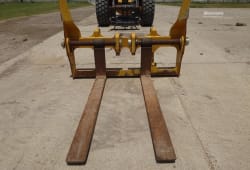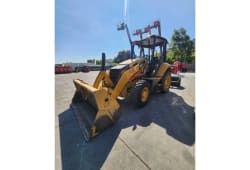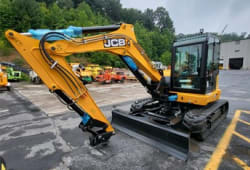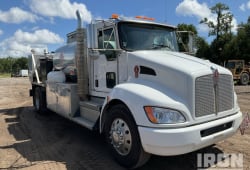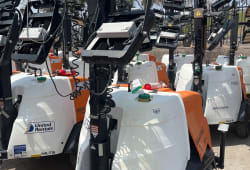Strategies on How to Find the Best Quality Logging Equipment
5 Min read
)
April 3, 2024
If you're in the market for logging equipment, you understand the importance of finding machinery that can withstand the rigors of heavy-duty tasks. Whether you're a seasoned logger or just starting out in the industry, having reliable equipment is essential for efficiency and safety. In this guide, we'll explore the steps to finding the best quality logging equipment that meets your needs and budget.
Researching Logging Equipment
Before diving into the purchasing process, it's crucial to research and understand your specific requirements. Consider the scale of your operations, the types of trees you'll be harvesting, and any terrain challenges you may encounter. By identifying your needs upfront, you can narrow down your options and make informed decisions.
Quality Indicators
When evaluating logging equipment, several factors indicate its quality and reliability. Look for machines built with durable materials that can withstand harsh working conditions. Additionally, consider the equipment's performance efficiency, ensuring it can handle the workload without compromising productivity. Checking the reputation of manufacturers can also provide insight into the overall quality of their products.
Comparing Brands and Models
The logging equipment market offers a wide range of brands and models to choose from. Take the time to compare features, specifications, and user reviews to find the best fit for your needs. Popular brands often have a track record of producing reliable machinery, but don't overlook lesser-known manufacturers that may offer competitive options.
Customer Reviews and Testimonials
One of the most valuable resources for evaluating logging equipment is customer feedback. Search online for reviews and testimonials from other loggers who have experience with the equipment you're considering. Pay attention to both positive and negative reviews to get a balanced perspective on its performance and reliability.
Consulting Experts
Seeking advice from industry professionals can provide valuable insights into the best logging equipment for your specific requirements. Attend trade shows, exhibitions, and industry events to network with experts and get recommendations based on their firsthand experiences. Don't hesitate to ask questions and gather as much information as possible before making a decision.
Exploring Options for Buying
When it comes to purchasing logging equipment, you have several options to consider. Decide whether you want to buy new or used machinery based on your budget and preferences. Explore local dealerships, online auctions, and equipment marketplaces to find competitive deals that meet your needs.
Warranties and After-Sales Support
Before finalizing a purchase, review the warranty policies offered by the manufacturer or seller. Understand the coverage provided and inquire about the availability of spare parts and after-sales support. Investing in equipment with reliable warranty protection can offer peace of mind and long-term savings on maintenance and repairs.
Cost Considerations
While cost is undoubtedly a significant factor in purchasing logging equipment, it's essential to consider the long-term investment versus short-term savings. Balance your budget constraints with the quality and durability of the machinery to ensure you're getting the best value for your money.
Inspecting Equipment
Before making a purchase, thoroughly inspect the logging equipment to ensure it meets your expectations. Create a pre-purchase inspection checklist and look for any signs of wear, damage, or malfunction. Consider hiring a professional inspector to provide an unbiased assessment of the machinery's condition.
Negotiating Deals
When negotiating prices for logging equipment, be prepared to advocate for yourself and negotiate terms that work in your favor. Research market prices and leverage any discrepancies or competitive offers to secure a better deal. Clarify payment terms and ensure all agreements are documented in writing before finalizing the transaction.
Finalizing the Purchase
Once you've negotiated a deal and are satisfied with the terms, review the purchase contract carefully. Verify that all specifications, warranties, and terms are accurately reflected in the agreement. Keep copies of all documentation for your records and follow any necessary procedures for payment and delivery.
Maintenance and Care
Regular maintenance is essential for keeping logging equipment in optimal condition and prolonging its lifespan. Establish a maintenance schedule that includes routine inspections, lubrication, and part replacements as needed. Following manufacturer recommendations and best practices can prevent costly downtime and repairs.
Troubleshooting and Repairs
Despite proactive maintenance efforts, logging equipment may encounter issues or breakdowns during operation. Familiarize yourself with common problems and troubleshooting techniques to address minor issues promptly. For more complex repairs, weigh the benefits of DIY solutions versus hiring a professional technician to ensure safety and efficiency.
Conclusion
Finding the best quality logging equipment requires thorough research, careful evaluation, and informed decision-making. By considering factors such as durability, performance, and customer feedback, you can invest in machinery that meets your needs and delivers reliable performance for years to come.
FAQs
What types of logging equipment are available in the market?
While we haven't discussed specific types in this guide, logging equipment encompasses a wide range of machinery, including chainsaws, skidders, harvesters, and forwarders.
How can I determine the right size and capacity of logging equipment for my needs?
Assess your operational requirements, including the volume of timber you plan to harvest and the terrain conditions you'll be working in. Consult with industry experts for personalized recommendations.
Are there financing options available for purchasing logging equipment?
Yes, many dealerships and manufacturers offer financing programs to help spread out the cost of equipment purchases. Explore your options and compare terms to find the best solution for your budget.
What should I do if I encounter issues with my logging equipment after purchase?
Refer to the manufacturer's warranty policy and contact their customer support team for assistance. If necessary, seek professional repairs from authorized service providers to ensure the equipment is properly maintained.
How often should I schedule maintenance for my logging equipment?
A: The frequency of maintenance depends on factors such as usage, operating conditions, and manufacturer recommendations. Establish a regular maintenance schedule and conduct inspections as needed to keep your equipment in top condition.

Caleb Woods is an experienced content specialist and an editor at Boom & Bucket, blending his journalism background with expertise in the heavy equipment industry. He delivers engaging, informative content to help professionals stay informed and make smarter decisions in the machinery market.



